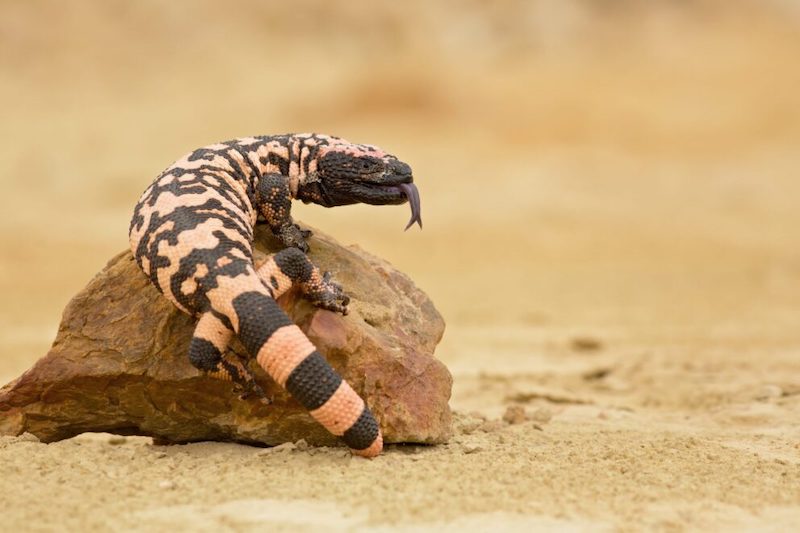The extreme temperature deviation as well as the unique topography of the Mojave make for distinct flora and fauna in the region. Among those are several lizard species, who thrive in a climate that humans would consider harsh and unforgiving. What follows are some of the most common species of lizards of southern Nevada.
Lizards of Southern Nevada

Chuckwalla: They’re big and flat and they may look mean, but the truth is that Chuckwallas are harmless herbivores who like to snack on flowers and moist leaves. They get all of their hydration from plants and never drink water, even when it is readily available. Chuckwallas might appear clumsy, but when under threat can scuttle between rocks quickly, inflating their lungs to wedge themselves in tightly so they can’t be grabbed easily by predators. Perhaps that’s why the Chuckwalla has one of the longest lifespans of all the southern Nevada lizards.

Desert Horned Lizard: A lizard species that gets around, the Desert Horned Lizard can also be found on our list of lizards of Northern Nevada. As we mentioned there, these lizards are often mistaken for horny toads—despite their long tails—due to the large pointed scales that protrude from the backs of their heads and along their bodies. Desert Horned Lizards are also picky eaters, preferring to subsist solely on ants, although they will eat other insects, spiders or vegetation if there’s not an anthill nearby.

Desert Iguana: If you want to spot a Desert Iguana in the wild, you must look near the creosote bushes upon which this species depends. They not only eat the buds and flowers of the creosote bush, but they also burrow under it as a means of concealment. Of the lizards of southern Nevada, Desert Iguanas are among the best adapted to the searing heat of the Mojave, which is why you’ll often see them out and about during the hottest parts of the hottest days.

Desert Night Lizard: With a name like “Night Lizard,” it probably comes as no surprise that this is a secretive species of reptile. They are almost never found in the open, preferring to live under the safety of cover and they burrow for their food—which consists of spiders, insects and other arthropods—as well. Because they spend the bulk of their lives in hiding, they have very few predators, but when pursued can escape quickly and will perform the lizard trick of dropping their tails if need be.

Gila Monster: Few lizard species are subject to more infamy than Gila Monsters. This is understandable given their large size, distinctive coloring and venomous reputations. In fact, Gila Monsters are the only venomous lizards of southern Nevada, but humans are not in danger from their venom-filled bite. Instead, they prefer to save their venom for defending themselves from predators. That, and their powerful jaw strength, make them more than able to fend for themselves in the sometimes-harsh desert environment. Unlike other lizards that dine on plants or insects, Gila Monsters prefer to eat eggs, only adding to their monstrous lore.

Great Basin Collared Lizard: Another lizard you’ll also find in northern Nevada, the Great Basin Collared Lizard’s appearance is marked by the pair of black bands around its neck from which it derives its name, as well as its long tail. It also bears the distinction of looking like a tiny dinosaur. This species is wide-ranging, evidence of which can be found in its other name, the Mojave Black Collared Lizard, indicating its presence in both major Nevada regions. When pursued, this diminutive lizard can maximize speed by running on its hind legs only.

Long-Nosed Leopard Lizard: Plentiful in numbers, the Long-Nosed Leopard Lizard can be found all over the state of Nevada and beyond. It’s a fast-moving lizard with a head and tail that are larger than its body and the spots from which it derives its name. It hunts by ambushing its prey, but when it finds itself caught, it will often hiss, squeal and deliver quite a painful bite. Ever the gluttons, these lizards have been known to choke to death trying to eat prey too large for them to swallow.

Western Brush Lizard: This lizard is small, slender and long, with a tail that often grows to twice the length of its body. They live in desert washes and drainages and prefer to hang out on the branches of trees and shrubs. Because it is well-adapted to the desert environment and is very tolerant of heat, it is a daytime hunter, searching for the arthropods that make up its diet. When the Western Brush Lizard needs to hide, it often does so by turning head-down on the branches of the creosote bush.

Western Red-Tailed Skink: Long and smooth, these snakelike lizards hang out in grasslands, desert shrubs and pinyon-juniper stands, preferably near water. Of all the lizards of southern Nevada, these skinks are among the most shy and the odds of your seeing one out in the open are slim. They generally eat insects but are not above preying on other lizards when hunger strikes. They get their name from the long, bright-red tails they grow as juveniles.
If you’re looking to gain a greater understanding of Nevada desert animals, including the lizards of southern Nevada, how they interact with their desert environment and how they’re impacted by human development and habitat destruction, please contact us!




Recent Comments